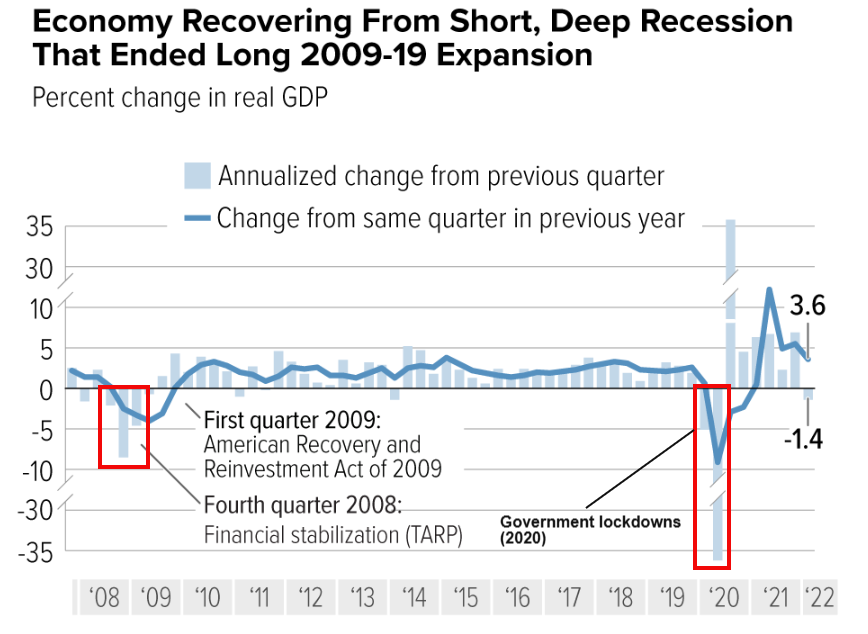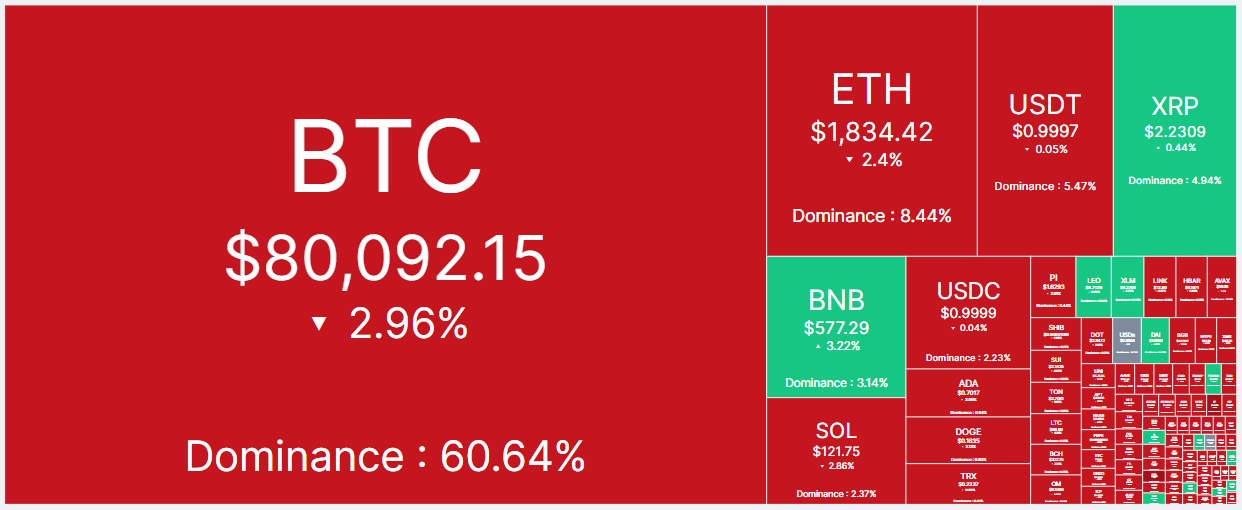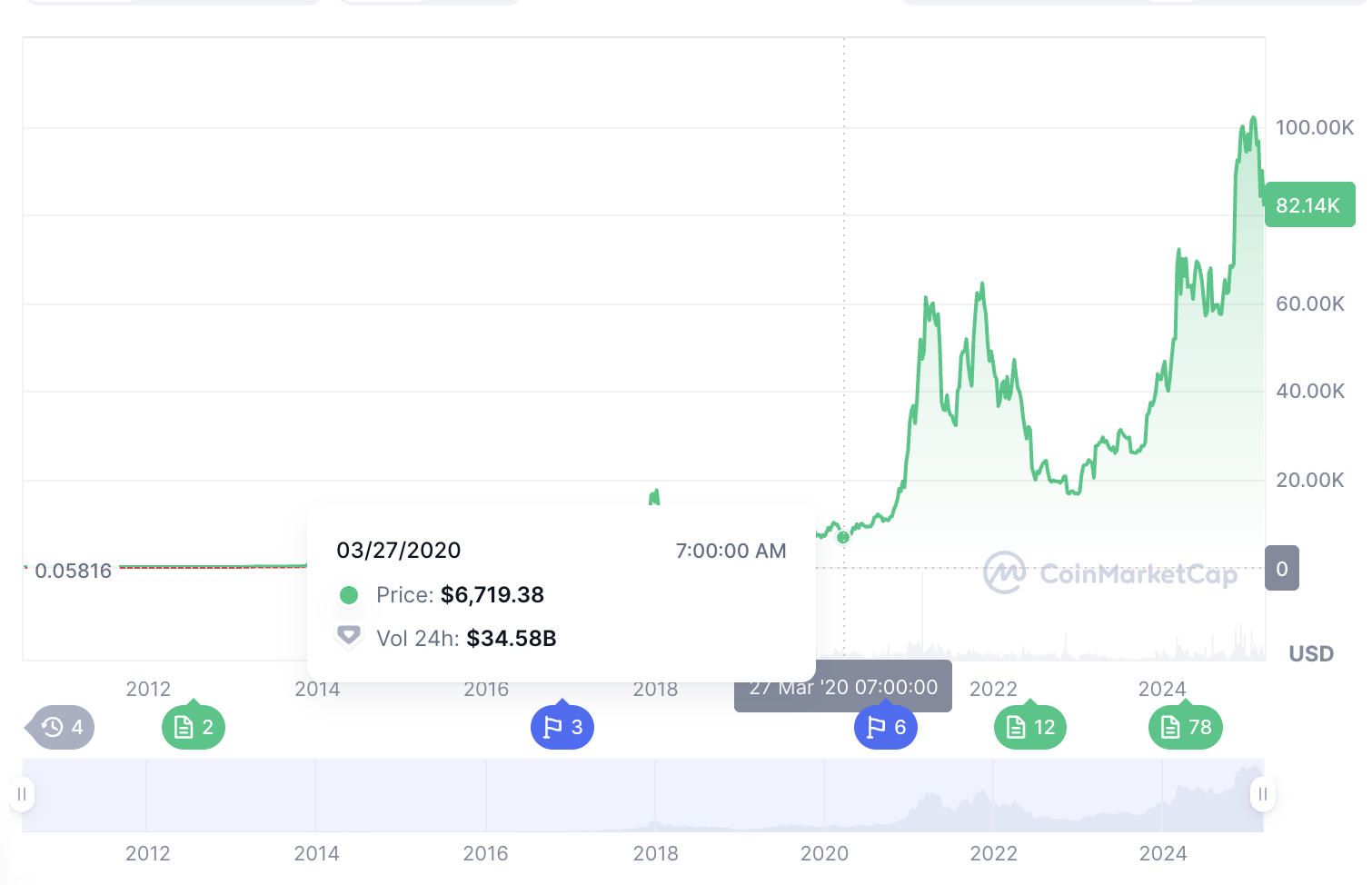Historically, U.S. recessions have upended global markets. With cryptocurrency now a key asset class in 2025‘s digitally connected and increasingly decentralized world, many investors want to know how a U.S. recession could impact the crypto market. Is Bitcoin a hedge, or will it sink too? Do altcoins have resilience amid wider financial pressures? Read on to find out.
KEY TAKEAWAYS
➤ A U.S. recession would likely have a negative impact on crypto markets, as economic downturns reduce investor risk appetite.
➤ Historical evidence shows that U.S.-initiated financial crises tend to spread globally, affecting speculative assets.
➤ Crypto market behavior in 2024–2025 suggests investors are already reacting to recessionary pressures.
➤ While a U.S. recession may impact crypto negatively in the short-term, this does not guarantee an extended downturn. Some historical evidence points to central bank responses to recessions leading to strong rallies (i.e., in 2021).
What is a recession?
In the United States, a recession is traditionally considered to be at least two consecutive quarters of negative gross domestic profit (GDP) growth. This definition has typically been adopted by financial analysts, journalists, and policymakers, in part because it is easy to understand.
However, the term is often misunderstood and politicized.

In 2022, the Biden administration and some economists emphasized the NBER’s broader definition. Though it was controversial, the definition more accurately reflects the reality of a recession in a changing world.
The NBER’s Business Cycle Dating Committee defines a recession as a significant decline in economic activity that is spread across the economy and lasts more than a few months. This assessment considers multiple factors, including real GDP, employment, industrial production, and consumer spending, rather than relying solely on GDP contractions.
This means that even if GDP contracts for two consecutive quarters, it does not automatically indicate a recession unless other economic indicators confirm a broader and sustained downturn.
The National Bureau of Economic Research (NBER), and specifically, its Business Cycle Dating Committee, is widely recognized in the U.S. as the authoritative body for officially determining the start and end dates of recessions. However, the NBER is a private, non-profit, non-governmental research organization (NGO).
The broader definition of a recession is important because the world is changing. Depending on the reason for the market downturn, a recession today may not look the way it did in the past — so may not affect crypto markets in the way we might expect.

Indicators used to determine a recession
There are several key indicators used to assess whether the U.S. is in a recession. These include:
- Real GDP: Takes nominal GDP and adjusts it for inflation, essentially measuring the value of goods and services produced using the prices of a base year.
- CPI: Measures inflation by tracking changes in the prices of a basket of goods and services that a typical consumer purchases.
- PPI: Measures changes in the average selling prices received by domestic producers for their output.
- Retail sales: Refers to the sale of goods and services directly to end consumers for personal or household use, either in-store or online.
- Job creation: The process of increasing the number of paid positions available in an economy or organization.
- Unemployment rate: The percentage of people in the labor force who are unemployed.
- Yield curve inversion: This occurs when short-term debt instruments (like Treasury bills) have higher yields than long-term debt instruments (like 10-year Treasury bonds).
- M2 money supply: A broad measure of the money supply that includes M1 (currency and checking accounts) plus savings accounts, money market accounts, and small-denomination time deposits.
- Housing market: The buying, selling, and renting of residential properties, including houses and apartments. The market encompasses the supply and demand, prices, and financing of these real estate transactions.
- Credit spreads: Represent the extra return investors demand for taking on more credit risk. Investors use credit spreads to assess the perceived risk of an investment relative to a risk-free benchmark.
- Delinquency and default rates: Delinquency refers to a borrower being past due on a payment, while default means a loan has gone into an extended state of non-payment.
- Stock market performance: Many Americans have significant exposure to the stock market. When stock prices rise, individuals feel wealthier.
A recession is typically declared retroactively or after it has already started or passed. The government does not officially declare a recession — it waits for the NBER’s determination. While the Federal Reserve doesn’t declare recessions, its policies can influence economic cycles and sometimes even trigger recessions.
How does the U.S. contribute to and impact crypto?
The United States plays a key role in the global crypto market. The region makes up a large share of cryptocurrency activity across multiple areas. This includes trading volume, startups, mining, developers, venture capital/investment, and more. According to Chainalysis:
- North America, primarily driven by the United States, accounts for 24.4% of global cryptocurrency transaction activity, with an estimated $1.2 trillion in value received on-chain between July 2022 and June 2023.
- The United States ranked first overall worldwide in cryptocurrency transaction volume, while Canada placed seventh globally.
- North America’s cryptocurrency market is heavily influenced by institutional activity, with 76.9% of transaction volume coming from transfers of $1 million or more.
Needless to say, the U.S. accounts for a significant portion of the crypto market’s mindshare.

How a U.S. recession could impact crypto markets
Given the U.S.’s substantial role in the crypto market and how recessions are determined, we can now examine how an economic downturn might impact crypto markets.
The crypto market is significantly influenced by U.S. economic activity. While this implies some inherent diversification with limited downside potential, it still leaves the crypto market vulnerable to changes in U.S. economic conditions. In the long term, however, monetary policy intended to ease the impact of a recession may benefit the crypto market (more on this a little later).
A U.S. recession would directly impact the risk appetite of U.S.-based investors, potentially causing them to withdraw from high-risk assets, including cryptocurrencies. However, the real concern lies in indirect, global contagion effects. Let’s take a look at some contributing factors.
1. Historical evidence of U.S. recession’s global impact
The U.S. economy plays a central role in global finance, trade, and investment. Many countries have a significant amount of exposure to U.S. assets, including stocks, real estate, and U.S. dollar reserves, as a safeguard against instability in their own currencies or economies.
The reality of the global economy’s dependence on the U.S. is laid out by the Dollar Milkshake Theory, which posits that the U.S. dollar will prevail against all other currencies, regardless of any global economic uncertainties. According to this theory, the U.S. dollar’s dominance will keep increasing as it sucks the liquidity out of other currencies.
Some of the most recent examples of this exposure causing a domino effect include the 2008 Global Financial Crisis (GFC) and the Federal Reserve rate hikes (2022-2024).
“In 2006 to 2007 another classic bubble developed. It was a big one, called the 2008 global financial crisis (GFC). It was led by the mortgage/real estate sector being financed by a lot of debt, which led to big debt problems that spread quickly to affect almost everyone in all countries, like the Great Depression in the 1929-39 period did.”
Ray Dalio, CIO of Bridgewater Associates
The GFC originated in the U.S. housing and financial sectors. It quickly spread globally due to interconnected banking systems and many banks outside of the U.S. holding collateralized debt obligations (CDOs) and mortgage-backed securities (MBS).
This resulted in severe recessions in Europe, Asia, Latin America, and elsewhere. Stock markets worldwide collapsed, asset prices fell, and risk appetite evaporated.
While crypto markets didn’t exist at scale in 2008, this historical event demonstrates that U.S.-initiated downturns can ripple through global financial systems and negatively impact risky assets broadly.
Global impact from Fed rate hikes
U.S. interest rate hikes (2022–2023) strengthened the U.S. dollar; conversely, emerging markets suffered. Currencies depreciated, borrowing costs rose globally, and economic stress increased worldwide. Global liquidity “dried up” significantly, affecting riskier asset classes, including crypto, equities, and venture capital.
Historically, when the U.S. economy contracts or when the Federal Reserve tightens monetary policy (e.g., such as through increased interest rates or quantitative tightening), it doesn’t impact U.S. markets alone.
It also strains global liquidity. This means increased borrowing costs, disrupting international trade flows and potentially triggering downturns elsewhere. We’ve seen evidence of this in 2023–2024, when rising U.S. interest rates contributed to economic stress globally, affecting asset prices beyond just American markets.
2. Trade and reserve currency exposure
About 60% of global currency reserves are held in United States Dollars (USD). Additionally, major economies heavily depend on U.S. economic conditions, directly through trade or indirectly through financial markets.
SponsoredAs the U.S. is a consumer economy, a slowdown in demand directly impacts manufacturing/export-driven economies (e.g., China, South Korea, Germany, and Japan), amplifying recessionary pressures globally. We’ve seen this play out as markets plummeted upon the threat of Trump’s tariffs.
Global financial institutions are heavily exposed to U.S. equity (e.g., stocks) and bond markets. U.S. recession fears typically prompt global financial deleveraging. History shows that U.S. downturns affect global investor sentiment, negatively impacting speculative investments, including cryptocurrencies.
U.S.-initiated financial crises (such as the GFC and Great Depression) have historically triggered global downturns, reducing global risk appetite and negatively impacting speculative markets. Macro evidence strongly suggests that a U.S. recession could negatively impact global markets, thus affecting global economic activity and, subsequently, crypto activity.
3. Signs of a recessionary environment
It is important to understand that governments rarely announce when a country is in a recession. However, identifying when a recession occurs, including the reasons why, can provide insight into how it will affect crypto markets and prices. From 2024 going into 2025, the U.S. experienced:
- High inflation despite monetary tightening.
- Record homelessness and increasing bankruptcies.
- Accelerating retail closures.
- Increased household debt, signaling financial stress.
- Weak job creation and rising unemployment.
These indicators align closely with previous recession scenarios. Several economic indicators suggest the U.S. may already be experiencing a recession, despite no official declaration from institutions.
Persistent inflation, increasing homelessness, rising bankruptcies, retail closures, increased personal debt, weakening employment data, and unemployment rates all align with recessionary patterns.
These economic pressures may explain the crypto market’s unusual performance: unlike previous bullish cycles, Bitcoin has maintained relative strength, while altcoins, including Ethereum, have underperformed. This reflects increased risk aversion among investors despite the U.S. being less than a quarter of the crypto market.

U.S. recession effects on crypto are indirect
To summarize, the U.S. makes up a significant portion of the crypto market but not the majority of it.
Despite this, the modern world is a complex web of economic (financial, monetary, and trading) relationships, with the U.S. at the center. Many nations depend on trade, USD, and access to U.S. markets and liquidity. Once these channels are constrained, it is likely to constrain other economies as well.
Therefore, a U.S. recession, while not directly affecting crypto, could spill over into other nations, causing economic downturns that would, in turn, affect crypto asset prices or activity globally.
Due to U.S. economic conditions from 2024 to 2025, we may already be witnessing signs of this constraint. This would explain investors’ hesitancy to go all in or stay in the crypto market altogether, evidenced by the constant fluctuations and volatility of crypto prices in Q1 2025.

Is there any way a U.S. recession could pump crypto?
Although a U.S. recession would typically be seen as negative for risk assets (including crypto), the U.S. government’s response to such economic downturns could actually help boost crypto prices.
Historically, recessions often trigger monetary policy easing — such as interest rate cuts and stimulus measures — to stimulate the economy. These actions can weaken the U.S. dollar and increase liquidity in markets, which may drive investors toward alternative assets.
As a result, both Bitcoin and altcoins could benefit from the influx of capital seeking higher returns or a hedge against inflation and fiat currency devaluation. So, while the recession itself may cause uncertainty, the broader economic response — especially if it involves loose monetary policy — might actually support a crypto rally.
Take the 2008–2009 Global Financial Crisis. While stock markets initially plunged, they rebounded following swift action by the Federal Reserve and federal government. Measures such as rate cuts, quantitative easing, and stimulus packages injected liquidity and helped fuel a market recovery.

Similarly, Bitcoin’s price saw a sharp drop when the COVID-19 pandemic first hit in March 2020. Yet, the impact on BTC’s price was short-term; COVID preceded the most notable crypto bull run to date, with crypto prices fueled by unprecedented monetary stimulus, and low interest rates (as well as a growing interest in decentralized assets).

The above chart shows the price of Bitcoin at the beginning of the COVID pandemic (which precipitated a devastatingly sharp contraction of economic activity in early 2020). At the end of March 2020, one BTC was worth less than $7000. Yet, less than a year later (by mid-March 2021) the price of BTC had exceeded $60,000. This is despite the fact that the global economy was in tatters.
The answer is macro
The idea of a U.S. recession triggering global downturns is plausible and well-documented historically (2008, early 2000s dot-com bubble, early 1990s recession, etc.). Crypto market shifts in risk appetite also support this theory. Macro evidence strongly reinforces the likelihood that a U.S. recession would negatively impact global markets, thus affecting global crypto activity.
However, this doesn’t necessarily indicate long-term doom and gloom. Recession-related downturns can be followed by strong rallies, often spurred by central bank responses. If markets are flooded with liquidity and weakened fiat currencies, historically, crypto assets become more attractive.
Disclaimer: This article is for informational purposes only and draws on historical examples to make generalized predictions. It should not be considered investment advice. Always do your own research. To hedge best against a recession, ensure your portfolio is diverse (including outside of crypto) and never invest more than you can afford to lose.
Frequently asked questions
A U.S. recession could affect crypto negatively. However, the affect would most likely be indirect, spilling over into other economies. This contagion could contribute to a global downturn, thereby putting downward pressure on crypto prices and reducing transaction volume overall.
There are many different ways that experts define a recession. They can look different in different periods of time or environments, making it difficult to define. Generally speaking, a recession is a decline in economic activity, spread across varying sectors of the economy and lasting more than a few months.
Many investors rebalance their portfolios into safer assets during recessions. Assets typically regarded as risk averse are sovereign bonds and precious metals. However, investors should keep in mind that this is liable to change, considering even real estate and related assets were considered risk averse before the 2008 Global Financial Crisis (GFC).

